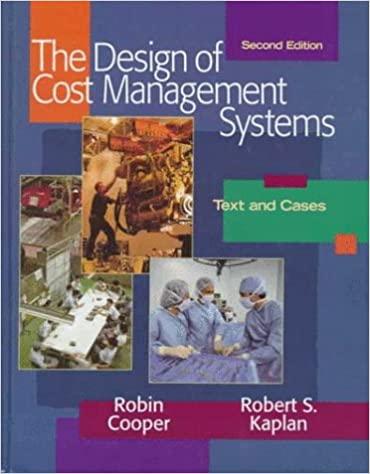Question
1. Samson Company produces mathematical and financial calculators and operates at capacity. Data related to the two products are presented here: Mathematical Financial Number of
1. Samson Company produces mathematical and financial calculators and operates at capacity. Data related to the two products are presented here:
Mathematical Financial Number of units produced 60,000 90,000 Direct materials costs $195,000 $252,000 Direct labor costs $192,000 $288,000 Direct labor hours 12,000 18,000 Machine hours 45,000 55,000 Number of production runs 60 30 Inspection hours 1,200 900 Required: a. Compute the total product cost and product cost per unit using a simple costing system with direct labor hours as the allocation base, using the following steps: (1) Calculate a manufacturing overhead (MOH) rate per direct labor hour by dividing total overhead by total direct labor hours (2) Allocate MOH to each product by multiplying direct labor hours used by each product by the MOH rate. (3) Compute the total product cost of each product by adding direct materials, direct labor, and MOH allocated. (4) Compute the product cost per unit by dividing total product cost by total units. b. Compute the total product cost and product cost per unit using an ABC costing system using the following allocation bases for each cost pool: Machining cost using machine hours, Setup costs using number of production runs, and Inspection costs using inspection hours, using the following steps: (1) Calculate a manufacturing overhead (MOH) rate for each cost pool by dividing costs by related allocation base, machining costs by machine hours, setup costs by number of production runs, inspection costs by inspection hours. (2) Allocate the costs of each cost pool to each product by multiplying the cost pool rate by the cost allocation base used. (3) Compute the total product cost of each product by adding direct materials, direct labor, and MOH allocated. (4) Compute the product cost per unit by dividing total product cost by total units. c. Comment on the results: How did the cost per unit of each product differ between the two methods?
Step by Step Solution
There are 3 Steps involved in it
Step: 1

Get Instant Access to Expert-Tailored Solutions
See step-by-step solutions with expert insights and AI powered tools for academic success
Step: 2

Step: 3

Ace Your Homework with AI
Get the answers you need in no time with our AI-driven, step-by-step assistance
Get Started


